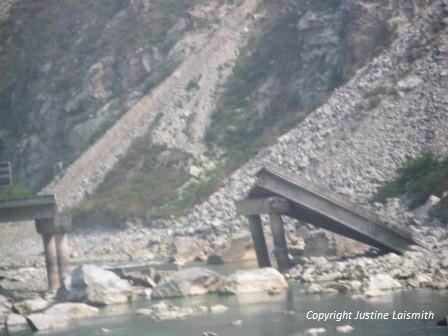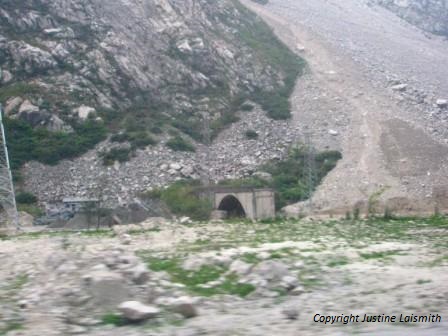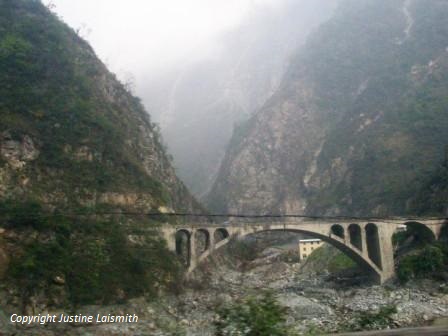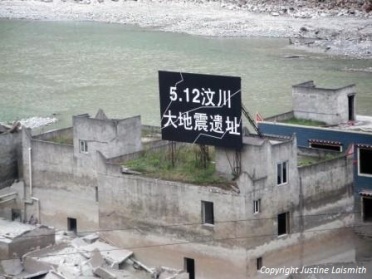On 12 May, China will be marking this day. Nearly a decade ago, in the spring when China and the world were looking forward to the Beijing Olympics in 2008. An earthquake of magnitude 7.9 struck south-west China on May 12, killing more than 68000 people, including over 5000 school children.
Nearly two years ago, on 8 Aug 2017, Jiuzhaigou in Sichuan, China, suffered an earthquake, magnitude 6.5. If you read my earlier articles, you’ll know that I’ve been to the UNESCO World Heritage Site Jiuzhaigou National Park. These two pictures give you an idea why it’s a renowned place. Sadly, the beautiful waterfalls and blue lakes were destroyed by the earthquake. It was a stark reminder. What Nature gives, she can take it all back.
After visiting Jiuzhaijou, I returned to Chengdu and took a day trip to Taoping Qiang, a village where the Qiang ethnic minority live. It was a long journey for a day trip. Sichuan is a very mountainous area. We went through tunnels that connected one mountain to another. We crossed over bridges in other areas. Tunnels, mountains, bridges and rivers were all part of the scenery. However, one section stood out. These were parts that were affected by the earthquake in 2008.
Here we were driving alongside a river, when I saw this broken bridge.

My guide described several of the places we drove past. As the area is highly mountainous, the earthquake dislodged enormous boulders that came down to ground level.
Here you can see how the rocks and earth have complete overwhelmed the bridge. The river here has dried up as the stones have stopped all water flow.

Here is another picture of a dried-up river.


On the day of the earthquake, when the rocks blocked up the river, a dam formed behind it. As a result, the river rose and flooded the villages on upper ground. This village is preserved as a memory of what happened on the day. You can see how high the water level rose to from the water marks left on the building.
This school, Xuankou Middle School, was also not restored so the public could see the devastation.
My guide gave me her personal account of that day. She was not working, but a friend of hers was. She texted and called, and texted and called, constantly, but did not get any response on the phone. Her friend, like so many others, had disappeared on the day and not heard from since. We were in the car when she relayed the story. She was sitting in front, next to the driver. I could not see her face, but from the tone of her voice, I could tell the memories was still fresh and the loss still raw.
It was a sobering experience. I wanted to mark, in some small way, to the lives loss.
When I decided my middle-grade story would be set in China, I had to give my characters authentic Chinese names. As this is a story written in English, this meant I had to give my characters names spelt in hanyu pinyin. Hanyu pinyin is a method of pronouncing Chinese words in Mandarin using the common alphabet system. However, like any language that uses the alphabets, not every letter of the alphabet sounds the way you expect in your native language. I thought hard about the names for my characters, like any expectant parent naming their child. For me, they had to be spelt in hanyu pinyin. In my head, I went through several common Chinese names and how they would be pronounced by readers who do not know hanyu pinyin. By the time my trip to China arrived, I had not thought of names of a couple of my characters – a pair of twins.
The Sichuan earthquake in 2008 was also known as the Wenchuan Earthquake. That very evening, when I returned to Chengdu, the twins’ names came to me. Wen and Chuan.
This article was first published 1 Aug 2018. Updated 7 Nov 2019 for the official blog tour of Secrets of the Great Fire Tree, published by Aurelia Leo.






Hey Justine,
Your pictures brought back the memories of my first visit to BeiChuan after the 2008 WenChuan earthquake, and then I came over and lived in ChengDu in 2009 to stayed and worked on the rebuilding loan and construction management from the world bank funding and worked in 22 different cities, seeing the devastation and the lives that were forever changed.
The earthquake lake, and the spillway construction was particularly fortuitous in that the resources were available to avoid a major disaster downstream if that dam had failed.
Appreciate your photos and my best to Wen and Chuan…
LikeLiked by 1 person
Oh wow, I didn’t know how the work goes on for the aftermath. Thanks for sharing your experience. Glad you like my photos.
LikeLike
This is such a sad post, my thoughts are with those who disappeared and their families.
LikeLiked by 1 person
Yes, it was a sobering moment on that trip.
LikeLike